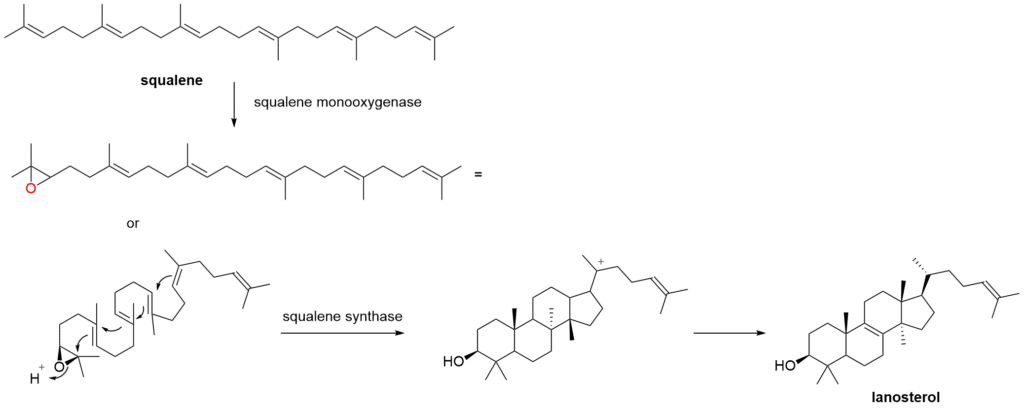Developing New Steroids at Symeres
Steroids continue to find wide application in the pharmaceutical industry, and R&D on new members of this broad structural class is still an ongoing process. At Symeres, for many years, we have contributed to research on new steroid-based drugs. We have completed many projects in which new steroids, of various classes, were synthesized and synthetic routes were developed or optimized. We have broad experience in bile acids and our work, for example, on estrone, testosterone, and progesterone includes modification of all the rings of the steroid skeleton as well as ring fusions and expansions. We have considerable experience in homologation of the steroid side chains and in developing routes for deuterium or carbon labeling. Glucuronide derivatives and other conjugates have been prepared for our customers. Knowing that steroids can be potent compounds and that working with steroids can pose significant health risks, Symeres requires strict adherence to our high standard operating procedures to minimize the risk of exposure.
Some background on this relevant class of compounds is provided below.
Steroids are a class of biologically active organic compounds that share a specific molecular core, consisting of four fused rings of carbon atoms. Three six-membered rings and one five-membered ring are connected in a specific manner, and the rings are usually referred to as rings A–D. This general structure is called gonane (Figure 1).

Figure 1: General Steroid Structure
The gonane skeleton gives steroids a characteristic three-dimensional structure, and additional atoms or functional groups are present to decorate the general structure further. Although in theory many stereoisomers of this nucleus are possible, in nature the saturated nuclear structures of most classes of steroids are alike, except for the junction of rings A and B. Simplified three-dimensional presentations may be used to illustrate the stereochemical details. Most common steroids, such as androsterone and cholesterol, have a trans fusion of the A and B rings, which provides a virtually flat template, with the substituted methyl groups perpendicular to this plane. In contrast, bile acid has a cis fusion of the A and B rings that gives it a bent structure (Figure 2).

Figure 2: Examples of steroid structures
Steroids are found in plants, animals, and fungi. All animal- and fungi-derived steroids are formed from lanosterol, whereas all plant-derived steroids are formed from cycloartenol.
Both precursors are derived from the triterpene squalene via a classical epoxidation/cyclization process (Figure 3).

Figure 3: Biosynthesis of lanosterol
Steroid hormones can be grouped into corticosteroids (typically produced in the adrenal cortex) and sex steroids (typically made in the gonads or placenta). Five types can be distinguished, according to the receptors to which they bind: glucocorticoids and mineralocorticoids (both corticosteroids) and androgens, estrogens, and progestogens (sex steroids). Vitamin D derivatives are considered a sixth closely related hormone system with homologous receptors.
Steroid hormones help control metabolism, inflammation, immune functions, salt and water balance, the development of sexual characteristics, and stress response.
Our body produces many different steroids at low levels; however, they are essential for maintaining overall health and well-being. Both males and females produce the same basic types of steroids, such as cortisol and cholesterol, but the levels and ratios of specific steroids can differ significantly between the sexes.
In contrast, some steroids serve entirely different functions, such as bile acids, the primary role of which is to facilitate fat digestion. Acting as surfactants, bile acids emulsify fats into micelles, making them easier to absorb.
Some Medicinal Steroids: Uses and Examples
In pharmacy, steroids are often used to treat conditions such as inflammation, autoimmune disorders, asthma, arthritis, and skin disorders, as well as being used for contraception. The term steroid is used for both naturally produced hormones and synthetic analogs. For medicinal purposes, steroids were traditionally isolated from natural sources, but, nowadays, they are mostly chemically synthesized.
Corticosteroids
Corticosteroids, such as aldosterone, are steroid hormones produced in the adrenal glands with potent anti-inflammatory and immunosuppressive properties. Synthetic derivatives, like cortisone, prednisolone, and dexamethasone, are widely used to manage inflammatory diseases, such as rheumatoid arthritis and bronchial asthma (Figure 4). Cortisol is commonly used for allergies and skin disorders like eczema and psoriasis.

Figure 4: Examples of corticosteroids
Sex hormones
Sex hormones are another class of steroids (Figure 5). The primary male sex hormone, testosterone, is responsible for the development of secondary sex characteristics. Two female sex hormones, progesterone and estradiol, control the ovulation cycle. The female sex hormones and their synthetic derivatives can be used as contraceptives.

Figure 5: Sex hormones
Anti-androgens and anti-estrogens
Antiandrogens block the effects of male hormones like testosterone and are used to treat conditions such as acne, hirsutism, androgenetic alopecia, and prostate cancer. Examples include medroxyprogesterone acetate and chlormadinone acetate. Antiestrogens, such as fluoxymesterone and norgestrel, block estrogen receptors or suppress estrogen production. Both are employed in therapies where estrogen modulation is beneficial, such as in breast cancer treatment or contraception (Figure 6).

Figure 6: Examples of anti-androgens and anti-estrogens
We hope to have demonstrated the vital role steroids play in nature. If you would like to explore more about steroid synthesis and characterization, we invite you to reach out to us for further information.
